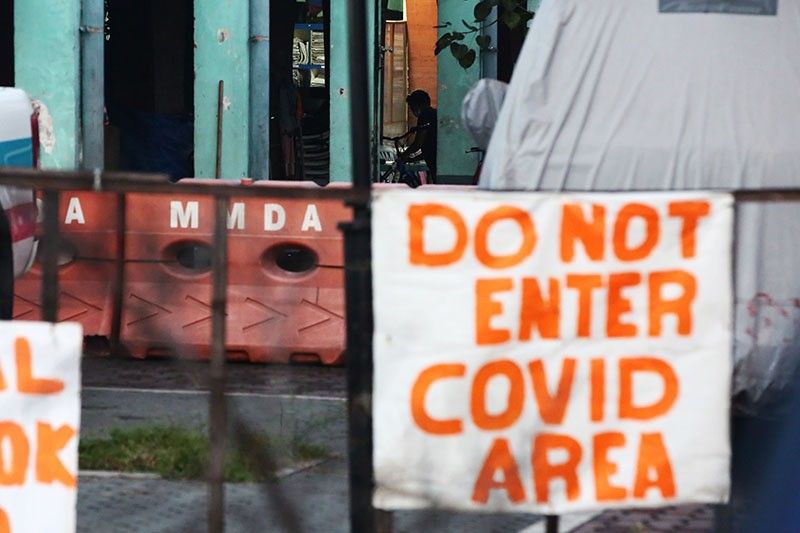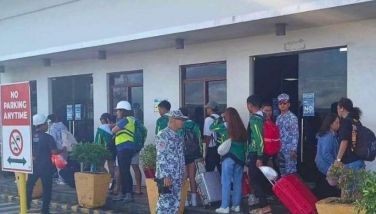A guide to the COVID-19 alert levels system

MANILA, Philippines (First published on Sept. 15, 2021; 10:58 a.m.) — Beginning October 20, the government will expand beyond Metro Manila its experiment on new coronavirus curbs in Metro Manila in the hopes of minimizing the spread of the virus while allowing some businesses to resume operations.
Under the new policy, the community quarantine classifications that people have grown familiar with would be trashed in favor of alert levels which would be based on the virus transmission rate, hospital bed utilization rate and intensive care utilization rate of a city or municipality.
Only two community quarantine classifications will remain: enhanced community quarantine and general community quarantine, where the new alert levels will come into play.
Instead of imposing region-wide lockdowns, the government will now impose granular lockdowns, where smaller areas will be placed under stricter mobility restrictions.
Still have questions about the new alert levels system? We answer some of them here.
What are the alert levels?
Alert Level 5
There are five alert levels under the new system, according to its guidelines released by the government’s pandemic task force, with Alert Level 5 being the highest and having the strictest restrictions which are identical to ECQ.
When an area is under Alert Level 5, coronavirus cases are “alarming” and hospital bed and intensive care utilization is at critical levels.
Alert Level 4
Alert Level 4 follows, where cases are high and/or increasing, and hospital bed and intensive care utilization are high.
Everyone except for those below 18, above 65, with immunodeficiencies, comorbidities and other health risks, and pregnant women can travel, subject to regulations set by the local government unit of destination.
Minors and those that the government identifies as part of the vulnerable population can still access essential goods and services and work in permitted industries and offices.
These same people can also enjoy point-to-point travel, staycations and individual outdoor exercises if they are fully vaccinated.
Some restrictions are eased under Alert Level 4, where religious gatherings, dining services, barbershops, salons, spas, gyms, and film, music and television production are allowed outdoors at 30% venue capacity. These activities are also permitted indoors, but only at 10% capacity and only for fully-vaccinated individuals.
Venues for meetings, incentives, conferences, exhibitions and parties, tourist attractions, amusement partks and theme parks, and recreational venues like internet cafes, billiard halls, amusement arcades, bowling alleys, skating rinks, archery halls and swimming pools are also allowed to operate at 10% capacity for indoor settings and 30% capacity for outdoor settings, provided they have a government-issed Safety Seal.
Licensure, entrance or qualifying examinations administered by government agencies and specialty exainations allowed by the government's pandemic task force are also allowed at the 10% indoor venue capacity and 30% outdoor venue capacity.
Gatherings for necrological services, wakes, inurnment and funerals for those who died of causes other than COVID-19 and for the cremated remains of those who died from the disease are allowed, but are limited to immediate family members.
The government’s pandemic task force determines these activities to be “high-risk for transmission” and will not be allowed to operate under Alert Level 4.
- Face-to-face classes for basic education, higher education or for technical, vocational education unless approved by the pandemic task force or the Office of the President
- All contact sports
- Cinemas and movie houses
- Funfairs/peryas and kid amusement industries like playgrounds, playroom and kiddie rides
- Venues with live voice or wind-instrument performers and audiences such as in karaoke bars, bars, clubs, concert halls and theaters
- Casinos, horse racing, cockfighting and operation of cockpits, lottery and betting shops, and other gaming establishments unless allowed by the pandemic task force or the Office of the President
- Gatherings in residences with individuals not belonging to the same household
- Government work shall be fully operational under Alert Level 4, but only 20% of its workforce will report on-site.
Alert Level 3
Alert Level 3 will be raised in areas where COVID-19 cases are high and/or increasing and there is increasing utilization of hospital beds and ICUs.
Restrictions on the movement of people based on age and comorbidities will be left up to the local government, subject to the oversight, monitoring and evaluation of the regional pandemic task force. These restrictions must not be stricter than what will be imposed under Alert Level 4.
Areas under Alert Level 3 will see a marked loosening of restrictions, with cinemas and movie houses and limited face-to-face classes for higher education and for technical-vocational education and training being allowed at 30% indoor venue capacity for fully vaccinated people and 50% outdoor venue capacity.
All the other activities permitted under Alert Level 4, including gatherings for wakes and funerals, are allowed at 30% indoor venue capacity for fully vaccinated people and 50% outdoor venue capacity.
The government’s pandemic task force determines these activities to be “high-risk for transmission” and will not be allowed to operate under Alert Level 3.
- Face-to-face classes for basic education unless approved by the pandemic task force or the Office of the President
- Contact sports, except those conducted in a bubble-type setup
- Funfairs/peryas and kid amusement industries like playgrounds, playroom and kiddie rides
- Venues with live voice or wind-instrument performers and audiences such as in karaoke bars, bars, clubs, concert halls and theaters
- Casinos, horse racing, cockfighting and operation of cockpits, lottery and betting shops, and other gaming establishments unless allowed by the pandemic task force or the Office of the President
- Gatherings in residences with individuals not belonging to the same household
Government agencies will be fully operational under Alert Level 3, with at least 30% of its workers reporting on site.
Alert Level 2
Alert Level 2 will be hoisted in areas where case transmission is low and decreasing, healthcare utilization is low, or cases are low but increasing, or cases are low and decreasing but bed utilization and ICU utilization is increasing.
The national government is again letting local governments determine movement restrictions based on age and comorbidities, as long as they are not stricter than what is imposed under Alert Level 4.
People not covered by these mobility restrictions are allowed to move in areas of the same or different community quarantine classification, subject to reasonable regulations of the LGU of destination.
Under this alert level, only casinos, horse racing, cockfighting and operation of cockpits, lottery and betting shops, and other gaming establishments would not be allowed to operate, unless permitted by the pandemic task force or the Office of the President.
Other activities that the government has placed restrictions on are allowed at 50% indoor venue capacity for fully-vaccinated individuals and at 70% outdoor venue capacity.
This includes limited face-to-face classes for basic education, subject to the approval of the Office of the President.
Government agencies will be fully operational under Alert Level 2, with at least 50% of its workers reporting on site.
Alert Level 1
Alert Level 1 is the loosest of all alert levels, where virus transmission is low and decreasing, total bed utilization rate and ICU utilization rate are low, and 70% of senior citizens, people with comorbidities and eligible population have been vaccinated.
All people are allowed to move and all establishments and activities are allowed to operate and be undertaken at full capacity, subject to minimum public health standards.
Who will declare the alert levels?
The Department of Health is mandated to identify the alert level. It will revisit the alert level weekly.
Who will declare granular lockdowns?
City and municipal mayors are empowered by the IATF to impose granular lockdowns on individual houses, residential buildings, streets, blocks, puroks, subdivisions and/or villages within their jurisdiction.
How long will granular lockdowns last?
According to IATF guidelines, granular lockdowns should last for at least 14 days.
Who can go out during granular lockdowns?
The IATF drastically trimmed down the list of people who can leave their homes during granular lockdowns. Only healthcare workers and other healthcare personnel would be allowed to move within, into and out of areas under granular lockdowns.
Overseas Filipino workers bound for international travel may exit areas under granular lockdown, while returning OFWs will be allowed to enter.
Similarly, people who left their homes before a granular lockdown took effect may return, but may no longer leave for the duration of the lockdown.
People under exceptional circumstances, including those who have emergencies, may be allowed to leave the area under granular lockdown.
Food and essential items intended for delivery in an area under granular lockdown are allowed, but only up until the border collection points designated by local governments.
Will there be aid to people under granular lockdown?
Yes. According to IATF guidelines, local governments and the Department of Social Welfare and Development will provide them assistance. Interior Secretary Eduardo Año previously said in a TV interview that this will be through the provision of food stubs.
Follow this thread for updates on COVID-19 risk levels, safety measures, and data from Metro Manila's local government units.
Photo: The STAR/Michael Varcas
Supreme Court suspends work from 12:30 p.m. on May 12 for disinfection of premises "in view of the increasing number of COVID-19 cases."
Senate President Migz Zubiri says that the whole Senate building will be placed under lockdown until Tuesday next week for thorough cleaning and disinfection.
This came after seven senators and some staff of the Senate tested positive for COVID-19.
Senate President Migz Zubiri says Sen. Grace Poe is recovering from COVID-19 and is not present at the Senate plenary session today. She is the fourth senator to catch the coronavirus in the past two weeks. — Franco Luna
Senate President Migz Zubiri says Sen. Cynthia Villar tested positive for COVID-19. She is third senator to test positive for the virus following Sens. Alan Peter Cayetano and Imee Marcos -- Philstar.com/Xave Gregorio
Daily growth rate in the National Capital Region is down to 2% from 3% of the previous day, according to OCTA Research.
OCTA Research fellow Guido David says the capital region could be close to the peak in new cases or the region has reached its limits in testing capacity.
NCR daily growth rate just 2%. The NCR could be close to the peak in new cases, or the NCR has reached its limits in testing capacity. @dzbb @dzrhnews @allangatus @News5PH @DZAR1026 @NewsRmn @dwiz882 @dzme_1530khz @EagleNews @ABSCBNNews @sofiatomacruz @PhilstarNews @haydeesampang pic.twitter.com/qkSPVvyf6e
— Dr. Guido David (@iamguidodavid) January 16, 2022
- Latest
- Trending
































